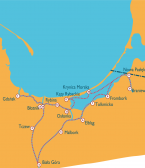- Day 1: Gdańsk – Błotnik
- Day 2: Błotnik – Tczew
- Day 3: Tczew – Biała Góra
- Day 4: Biała Góra – Malbork
- Day 5: Malbork – Elbląg
- Day 6: Elbląg – Tolkmicko
- Day 7: Tolkmicko – Frombork
- Day 8: Frombork – Braniewo (Nowa Pasłęka)
- Day 9: raniewo (Nowa Pasłęka) – Krynica Morska
- Day 10: Krynica Morska – Kąty Rybackie
- Day 11: Kąty Rybackie – Osłonka
- Day 12: Osłonka – Rybina
- Day 13: Rybina – Błotnik
- Day 14: Błotnik – Gdańsk
Day 1: Gdańsk – Błotnik / 11,9 sm
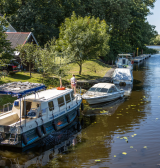 The tour starts in the old town of Gdańsk. You enter the Motława and pass the new drawbridge in the centre. At the first fork, proceed on the Dead Vistula (Martwa Wisła) and follow it to turn straight right into the harbour of Błotnik.
The tour starts in the old town of Gdańsk. You enter the Motława and pass the new drawbridge in the centre. At the first fork, proceed on the Dead Vistula (Martwa Wisła) and follow it to turn straight right into the harbour of Błotnik.
If you have time for a short taxi trip, you can find several good restaurants on the western shore of the Vistula breakthrough in Świbno (approximately 7 kilometres from the Baltic Sea).
Day 2: Błotnik – Tczew / 14,6 sm
On the way to Tczew you have to pass the lock in Przegalin and you then head south to Tczew. There, you can learn more about the history of the Vistula by visiting the Vistula Museum. Near the small boat harbour of Tczew, there is a restaurant and a hotel.
Day 3: Tczew – Biała Góra / 13,5 sm
In order to reach this stage’s destination, Biała Góra, it is necessary to know the current water level before entering the Vistula. This section has a tendency to meander, is interspersed with groynes and the stone reefs at Piekło can be tricky when the water level is low.
The lock allows access from the Vistula into the Nogat. If the water level is high, water flows from the lock into the Nogat. This should be taken into account when docking at the Biała Góra harbour.
Day 4: Biała Góra – Malbork / 10,8 sm
On the way to Malbork, directly after Biała Góra, a nature reserve begins on the north-western side. The Mątawski Forest up to Malbork makes this the most scenic stage of this tour. Next to a hydro-electric power station is the first lock (from 1914) on the route. Malbork then hoves into view.
Boats can be moored directly next to the Malbork Castle. However, it is also possible to moor quietly and safely in the small boat harbour park of Północny not far behind the bridge, on eastern shore side. A visit to the Magic Malbork festival, which commemorates the siege of the castle, is a must.
Day 5: Malbork – Elbląg / 21,6 sm
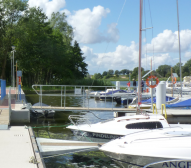 Along the Nogat you now head to the Vistula Lagoon and to the mouth of the river. In Kępki, you pass a fixed bridge (clearance height 3.3 m), which is the lowest fixed bridge on the tour.
Along the Nogat you now head to the Vistula Lagoon and to the mouth of the river. In Kępki, you pass a fixed bridge (clearance height 3.3 m), which is the lowest fixed bridge on the tour.
To avoid the detour via Zalew Wiślany, use the Jagielloński Canal, which was built in 1438. It connects the Nogat with the River Elbląg. After approximately 6 kilometres, you reach the River Elbląg. The recommendable mooring area at the Jachtclub Elbląg, is the first option on the west shore of the River Elbing and is approximately 5 kilometres away from the city centre.
With its two historical drawbridges and a beautifully reconstructed old town including several churches, Elbląg is well worth a visit. For culinary delights, the Zmysły.
Day 6: Elbląg – Tolkmicko / 15,1 sm
On the way to the Vistula Lagoon across the RiverElbląg there is a lot of shipping traffic. So, please take note that commercial shipping has the right of way. You pass the pontoon bridge near Nowakowo, which opens every hour throughout the year, and remains closed during low or high water. After the pontoon bridge, the route continues via Elbląą Bay (Zatoka Elbląska) into the Vistula Lagoon. Shortly after the mouth of the Nogat, the south-bending Tolkmicko fairway commences. It is essential to keep to the defined waterways, first along the canal and then on the lagoon, because of shallow waters to both the left and the right riversides! Docking at the modern marina of the Fishing Harbour Tolkmicku should not be problematic at all.
Tolkmicko has a pretty little old town, shops for all your daily needs and some small pubs like Smažalnia Ryneczek. You can also find fish for sale directly in the harbour.
Day 7: Tolkmicko – Frombork / 10,2 sm
The next stage destination of Frombork in the Warmia-Masuria Voivodship is reached by heading east over the main fairway.
Frombork’s 13th century cathedral, with its adjacent buildings and planetarium comes into sight soon. In the 16th century, canon Nikolaus Kopernikus developed his theory of the heliocentric world view here.
The Tawerna Pod Żaglami is located directly in the harbour.
Day 8: Frombork (Nowa Pasłęka) – Braniewo / 1 8 sm
Shortly before the Russian border lies the somewhat abandoned location of Nowa Pasłęka. However, if the vision of an opening for international boats where to become a reality, this place would quickly become more relevant.
Shortly before the closed drawbridge (clearance height 2.2 m) a boat dock has been built in the Nowa Pasłęka. There is another one located along the “old” Pasłęka in Braniewo. It is hard to imagine that a Hanseatic seaport was once operated from here. Today, beer is brewed on site and there is the excellent Spichlerz Mariack restaurant to stop at for a bite to eat.
Day 9: Braniewo (Nowa Pasłęka) – Krynica Morska / 14 sm
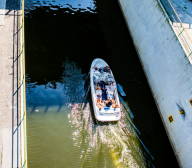 Krynica Morska is located on the other side of the Vistula Lagoon, on the south side of the Vistula Spit and opposite Tolkmicko with its long, sandy beaches on the outer coast. You can head to the harbour via the buoyed fairway – docking is therefore unproblematic. Cross the resort and the pinewoods behind it to reach the beautiful beaches of the Baltic Sea.
Krynica Morska is located on the other side of the Vistula Lagoon, on the south side of the Vistula Spit and opposite Tolkmicko with its long, sandy beaches on the outer coast. You can head to the harbour via the buoyed fairway – docking is therefore unproblematic. Cross the resort and the pinewoods behind it to reach the beautiful beaches of the Baltic Sea.
From the lighthouse, there are beautiful views of the Baltic Sea and the Vistula Lagoon. One place worth a visit is the Hotel Kahlberg and its restaurant.
Day 10: Krynica Morska _ Kąty Rybackie / 14 sm
Der Hafen von Kąty Rybackie liegt im nordwestlichen Eck des Frischen Haffs. Kąty Rybackie war ursprünglich ein altes Fischerdorf. Doch der nahe Ostseestrand und der Ausbau der touristischen Infrastruktur ziehen immer mehr Touristen an. Im Sommer sprüht hier das Leben. Das Wellnesshotel Tristan mit sehr guter Küche befindet sich am westlichen Ortsrand. Von hier aus ist der Strand fußläufig erreichbar.
Day 11: Kąty Rybackie – Osłonka / 8,6 sm
Vom Frischen Haff kommend, führt der Weg nach Osłonka über die Szkarpawa. Nach etwa zwei Kilometern liegt der kleine gut ausgestattete Anleger Osłonka an der südlichen Uferseite.
Day 12: Osłonka – Rybina / 11,3 smm
Weiter entlang der Szkarpawa geht es von Osłonka aus nach Rybina. Von hier ist ein Abstecher entlang der Wisła Królewiecka (Königsberger Weichsel) nach Sztutowo möglich. In Sztutowo kann die Gedenkstätte des ehemaligen Konzentrationslagers Stutthof – etwa 2 Kilometer entfernt vom Hafen – besichtigt werden.
Day 13: Rybina – Błotnik 11,9 sm
Von Rybina über Drewnica geht es durch die Schleuse von der Szkarpawa wieder zurück auf die Weichsel. Die nächste Brücke und Schleuse wartet bei Przegalin auf die Bootsfahrer. Danach ist die Weiterfahrt bis zum Zwischenstopp in Błotnik ohne weitere Beeinträchtigungen möglich.
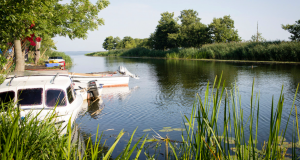 Alternative: Kąty Rybackie – Sztutowo (Stutthof) – Rybina via Wisła Królewiecka (Königsberger Weichsel) Eine zweite, deutlich abenteuerlichere Möglichkeit besteht darin, den Weg über die Wisła Królewiecka mit dem Ziel Rybina zu nehmen. Passiert werden kann der Fluss mit Booten bis zu einem Tiefgang von 1,6 Metern. Vorsicht bei der Einfahrt in den Fluss vom Frischen Haff aus. Hier gibt es einige Untiefen. Die Klappbrücke Sztutowo/Most Czterech Pancernych Stutthof) hat seit 2008 wieder feste Öffnungszeiten. Kurz hinter der Brücke liegt auf nördlicher Uferseite die Bucht der Marina Baltica, wo man sicher liegt. Die Gedenkstäte des ehemaligen KZ Stutthof liegt etwa 2 Kilometer westlich des Hafens.
Alternative: Kąty Rybackie – Sztutowo (Stutthof) – Rybina via Wisła Królewiecka (Königsberger Weichsel) Eine zweite, deutlich abenteuerlichere Möglichkeit besteht darin, den Weg über die Wisła Królewiecka mit dem Ziel Rybina zu nehmen. Passiert werden kann der Fluss mit Booten bis zu einem Tiefgang von 1,6 Metern. Vorsicht bei der Einfahrt in den Fluss vom Frischen Haff aus. Hier gibt es einige Untiefen. Die Klappbrücke Sztutowo/Most Czterech Pancernych Stutthof) hat seit 2008 wieder feste Öffnungszeiten. Kurz hinter der Brücke liegt auf nördlicher Uferseite die Bucht der Marina Baltica, wo man sicher liegt. Die Gedenkstäte des ehemaligen KZ Stutthof liegt etwa 2 Kilometer westlich des Hafens.
Day 14: Błotnik – Gdańsk 11,9 sm
Von Błotnik verbleibt man auf der Martwa Wisła bis zum Abzweig in die Motława. Die schön gelegene Marina Gdańsk wird nach Passieren der Fußgängerbrücke erreicht.
